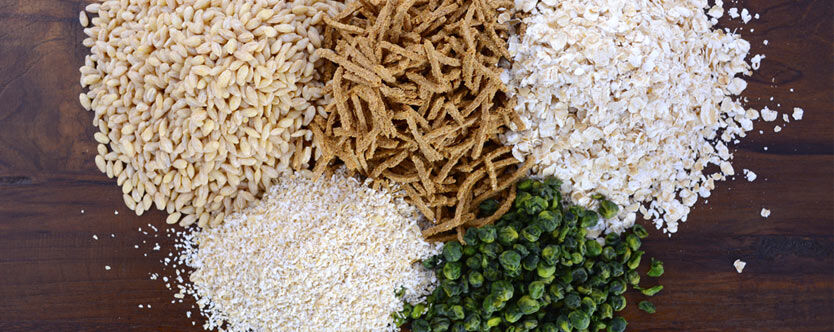
Importance of Fibre
I would like everyone to know about the value of fibre. “Fibre” is that part of the food which is not digested. It passes through the large intestine unchanged. It provides no nutrients or any material for growth and repair and yet has untold health benefits. High-fibre Indian diet has virtually no calories. It entangles nutrients within its walls and you need to break it down to release the nutrients. When you consume a high-fibre Indian diet in the form of chappatis (as in wheat flour, bajri, soya bean, oatmeal, millets) or brown rice or bread (as in whole-wheat bread) your body reacts as follows:
- Insulin response is better
- Satiety response is faster
- Blood cholesterol levels are better
- Transit time increases
Now, when you consume a fibre-stripped food as white or polished rice, cornflour, white flour i.e. maida (like white bread, naan, rumali roti), glucose, maple syrup, fruit juice, and refined sugar, your body reacts as follows:
- Low fibre food eaten over the years precipitates hypoglycemia and Type II diabetes
- You get constipation
- Appetite increases
- Blood lipids shoot up.
- You are prone to cancer
Removing fibre from diet is like removing the very life out of your body. What remains is JUNK! That is why fibre-stripped foods are termed as junk – like pizzas, burgers, french fries, chips, samosas, chakli, sev puris, pastries, batata wadas, white bread sandwich, and bhel puri, among others.
When you mash whole grains, the fibre is almost always left behind. By removing fibre from carbohydrates, we are manipulating nature’s food design. Also, the body cannot handle the ‘new form’ efficiently, so it gets pushed towards disease and death. Evidence relating to the lack of fibre intake leading to ill health is overwhelming.
Lack of high-fibre Indian diet affects most disease conditions such as breast, ovarian and pancreatic cancer, heart disease, diabetes, high blood pressure, prevents discomfort from constipation, hemorrhoids, hernia, gall stones, and skin problems. High-fibre Indian diet offers protection to even those who consume a high amount of sugar and fat. Presence of fibre in food prevents fluctuations in blood sugar level and soluble fibre as in oat bran and guar gum. These to help decrease cholesterol and triglyceride levels. In other words, it prevents the absorption of sugars and fats to a great extent.
We in the metros are becoming progressively malnourished not because of a shortage of food but because of low fibre and low-nutrient levels existing in our new refined food pattern on which we tend to overfeed ourselves. Our food pattern is getting westernized and we are getting undernourished.
Have a look at the eating patterns given below to know what we used to eat & what we are presently eating.
The High-fibre Indian Diet (What it was?)
Breakfast
1 cup tea + Methi/gobi/muli paratha with curd or lassi & green chutney
Lunch
Naachni/Jowar/Bajri chappatis(home ground atta) + Some vegetables (farm fresh) + Lots of raw radish & carrots + Usal (made from the whole mung)
Tea
1 cup tea or badam milk + Lots of dry fruits + Boiled green channa or boiled peanuts
Dinner
Bhakri or unpolished rice / Red rice + Any dal + Vegetables
Availability and consumption of raw farm-fresh fruits & vegetables were much more in the earlier days like tender turnips, raw peanuts, raw beans, vaangi (long cucumbers) fresh green channa, raw navalcole, berries, carrots, radish, fresh green peas, a better quality of leafy vegetables. Of course, all these foods are available even today, but with the variety of junk snacks available and well-targeted advertisements, I find the younger generation is totally averse to eating any vegetables whether raw or in the cooked form.
Fibre-stripped Indian Diet (What it has become)
Breakfast
1 cup tea/coffee or White bread sandwich or Milk and cornflakes or Egg and toast+butter & cheese or Orange juice / Apple juice & cheese toast
Lunch
Pulao / Biryani / Steamed Rice (made from polished rice) + Dahi Khadi or vegetable curry or Non-veg curry + Chappaties (made from readymade aata) + Curd
Tea
1 cup Tea / Coffee/ Soft drinks / French fries & burgers or Chips or Pizza or Biscuits (most of them are made from maida) or a slice of cake or a chocolate or a samosa
Dinner
It could vary from being a Chinese meal as in noodles with vegetables full of corn starch or Chicken in cornstarch or Pav bhaji or idli sambar or cream & grilled potato, tomato and cheese sandwiches or Pasta with cheese sauce and vegetable / non-veg or Bread and baked vegetables in white sauce or Chicken in brown sauce or Chole batura.
